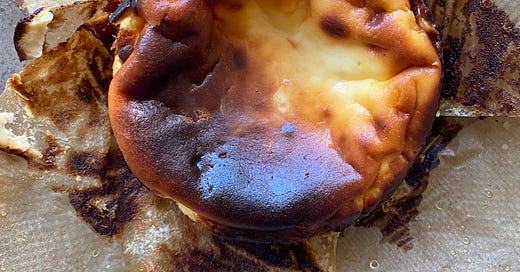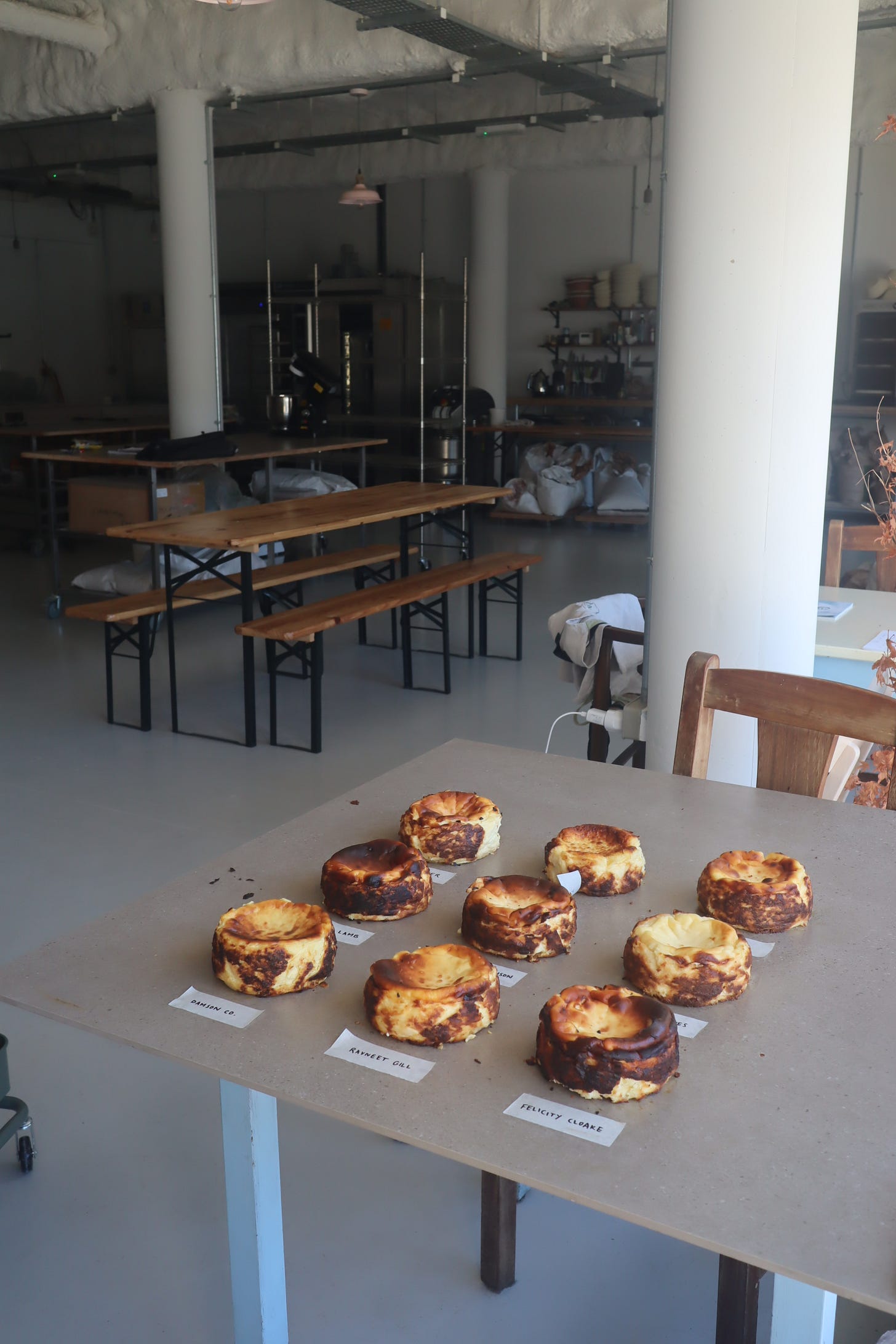A Basque Cheesecake Recipe Test
How I go about testing recipes, plus my recipe for Basque Cheesecake
What I’m reading: this (slightly dated) New Yorker piece by Anthony Bourdain - June 25th would have been Bourdain’s 67th birthday, so it feels like a good time to revisit some of his first published writing.
What I’m listening to: Off Menu Podcast with Arlo Parks.
What I’m eating: Oreo ice-cream sandwiches, that I don’t think we have in Ireland but are in every cornershop here, and they are TOP TIER.
My recipe testing process
I started doing these tests a few years ago with my friend Mary, and they quickly became the theme of my Instagram. The idea behind these recipe tests is that you bake 9 different recipes for the same thing (i.e., Basque cheesecake), and then by the end, you’ve learned enough to develop your own recipe. I’ll usually find that I like the flavour of one, the texture of one, the mixing method of one etc., so the final recipe is a bit of a hybrid, sometimes with my own twist.
I tested Basque cheesecake last year, which was actually a really fun one to do: there’s only one element (unlike something like pasteis de nata, which have a custard and a laminated dough), and you bake them hot and fast, so it didn’t take too long. I baked them all in one day, and let them set in the fridge overnight, before tasting them. I will say that I’m not the biggest fan of cheesecake: I often don’t like the texture, and the thought of a gelatine-set cheesecake makes me shudder slightly. However, Basque cheesecake, in my opinion, fits into a different category. It’s got the contrast in textures between the dark, caramelised crust and the creamy, light interior, and I like the flavour, which is usually citrus or vanilla, and generally has a slightly sour component (e.g. crème fraîche or sour cream).
I always start by asking the Instagram community what their favourite recipe is for whatever it is I’m testing. Usually, certain recipes emerge as firm favourites (and backed by exceedingly forceful recommendations), and I’ll narrow it down to the top 9. I like to include my own current favourite recipe, and try and get a good mix of recipes in general - i.e., for the chocolate chip cookie test, I made sure to include a range of different types of chocolate chip cookie, in order to be able to be able to draw conclusions about the effects of different recipe proportions, baking time etc.
After analysing each cheesecake individually, I analysed them thematically according to several variables: baking, ingredients, tin size, texture, mixing method. Here are my conclusions:
Baking
There’s almost no point giving a baking time for this as it varies so much between ovens - but I back preheating to the max and turning it down to 250C for the duration of the bake. Aim for a dark crust but a generous wobble when shaken. @nicolaalamb recommends an internal temp of 60-65C if you’re into probing. Basically you just gotta get to know your oven, take it out for dinner etc.
Ingredients
I used Tesco “soft cheese”, but hear me out. It’s higher in fat than Philadelphia (12% vs. 9%), and cheaper (€2.95/kg vs. €14.25/kg), so IMHO, a logical choice. Ideally we’d all be using organic artisan dairy for this, but at present, high fat content and stability are my priorities (in life and baking).
Tin size
I baked all of mine in 5” tins, but I wouldn’t go smaller than 5” as you’ll struggle to get the different textures right. The recipe I posted last week is in a 7” tin so you can use π to calculate the right quantities for your tin (or @nicolaalamb has a handy table).
Texture
You’re looking for a very specific texture here, described pretty perfectly by @nigelslater : “a cake that wobbles mousse-like on the fork. The centre may quiver when shaken. A thoroughly good thing.” @ravneeteats says to bake until “dark on top and puffy, it may crack a little around the edges, which is fine. It should be jiggly in the middle, though.” @felicitycloake recommends baking until “the top is deeply brown and more importantly, the middle is still wobbly and liquid; you’ll think it will never set, but it will as it cools”.
Mixing
You really have to have your ingredients at room temp before starting, and don’t forget to scrape the sides of the bowl between each addition so it’s nice and homogenous. When incorporating flour, a liaison batter is my fave method, or you can strain it either to catch any rogue lumps.
Recipe: Basque Cheesecake
Here’s my recipe for Basque cheesecake based on the above analysis and my personal preference: it’s citrussy and flavourful, and if baked properly, will have the perfect textural contrast between the crust and the interior.
Ingredients: (for a 7”-8” cheesecake)
560g cream cheese (Philadelphia is grand, or Tesco “soft cheese” is also good)
200g crème fraiche
100g cream (single or double is fine)
4 eggs plus 2 yolks
220g caster sugar
35g cornflour
Pinch salt
1 lemon and 1 orange, juice and zest
2 tsp vanilla
IT IS VERY IMPORTANT THAT ALL YOUR INGREDIENTS ARE AT ROOM TEMP. I’m sorry for shouting but this is vital.
Method:
1. Get your oven on full whack. Preferably above 280C.
2. Line your tin with 2 sheets of baking paper at perpendicular angles (kinda in a cross). There should be lots of overlap and that is OKAY, just try and have the edges smooth so that the batter doesn’t escape into the tin.
3. Beat cream cheese with sugar until very smooth and the sugar has dissolved. This is best done in a stand mixer, but you can also do it by hand. Scrape the edges of the bowl thoroughly with a spatula.
4. Add the eggs and yolks one at a time, mixing fully each time and scraping down the sides periodically.
5. Add the crème fraiche and cream slowly, mixing all the time and scrape again. Add vanilla and lemon zest and juice and stir.
6. Put the salt and cornflour in a separate bowl and add a couple of tablespoons of the mixture in. Whisk until it’s really smooth, then add that back to the bowl and stir until completely combined.
7. Pour the batter into the tin and tap hard against the counter a couple times.
8. Put in the oven and drop the temp to 250C.
9. Bake approx 30 mins, but tbh it completely depends. You want a nice dark crust on top, but still a severe jiggle in the middle. Don’t overbake because it’ll be rubbery, but also don’t underbake because it won’t slice nicely. Just bake it perfectly, ok?
10. Let it cool and refrigerate overnight. The next day, let it come back to room temp before slicing with a SHARP knife
Paid subscribers can see the full table below: how I scale down recipes so that they all turn out the same size (essential for Instagram-worthy pics), and how I decide which variables/ingredient ratios to test.
Keep reading with a 7-day free trial
Subscribe to Tastebuds to keep reading this post and get 7 days of free access to the full post archives.









